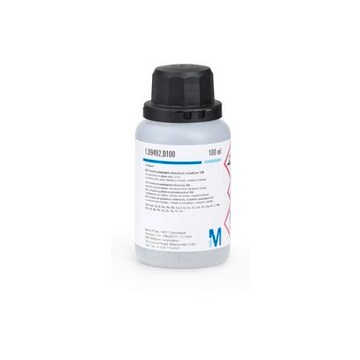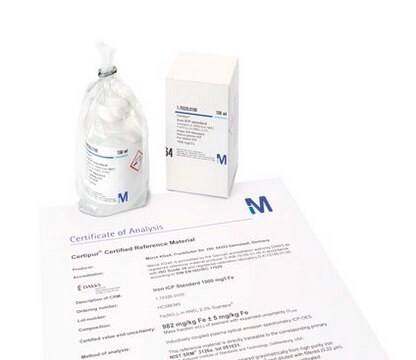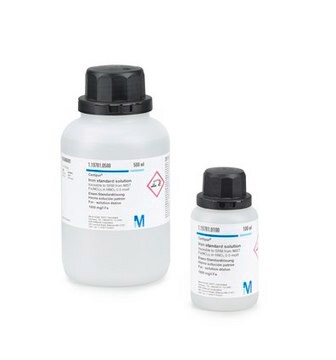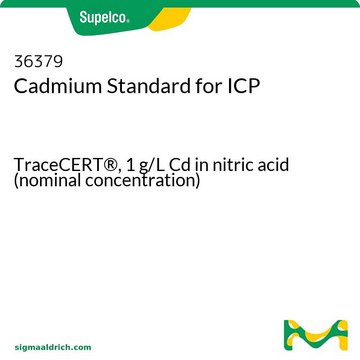1.70333
Mercury ICP standard
traceable to SRM from NIST Hg(NO₃)₂ in HNO₃ 10% 1000 mg/l Hg Certipur®
Synonym(s):
Mercury Calibration Standard for ICP
About This Item
Recommended Products
grade
certified reference material
Quality Level
Agency
suitable for EPA 200.7
suitable for EPA 200.8
product line
Certipur®
technique(s)
ICP: suitable
density
1.054 g/cm3 at 20 °C
application(s)
industrial qc
pharmaceutical
format
single component solution
storage temp.
15-25°C
General description
Please visit ISO certificates and Site Quality Self-Assessments to access the current certificates of accreditation.
Download your certificate at http://www.sigma-aldrich.com to view certified values, including uncertainty, date of expiry, and detailed information about trace impurities.
Application
- Mercury ICP standard for trace metal analysis: A study utilizes ICP-MS to assess comparability and uncertainty in analytical methods for methylated mercury species in seawater, demonstrating the critical role of mercury ICP standards in environmental monitoring and trace metal analysis (Anal Chim Acta, 2023; doi: 10.1016/j.aca.2023.341735).
- High-purity mercury calibration standard for ICP-MS: Research highlights a broad-applicability method for mercury speciation in various seafoods using ICP-MS, emphasizing the necessity of high-purity mercury standards for accurate and reliable trace metal quantification (Anal Methods, 2023; doi: 10.1039/d3ay00289f).
- Mercury standard for pharmaceutical impurity testing: An innovative application discussed involves the comparative toxicity of interferon beta-1a impurities, including heavy metal ions, underscoring the importance of mercury ICP standards in pharmaceutical quality control to ensure safety and compliance (Medicina, 2022; doi: 10.3390/medicina58040463).
- Traceable mercury ICP standard for biochemistry research: A study on the quantitative mapping of mercury in mushroom fruit bodies using ICP-MS validates the need for traceable mercury standards in biochemistry research, facilitating detailed elemental distribution analyses (Anal Bioanal Chem, 2022; doi: 10.1007/s00216-022-04240-y).
- Mercury reference material for biotech quality control: Research integrating smartphone-based electrochemical analysis with NFC systems for the detection of heavy metals showcases the utility of mercury ICP standards as reference materials in developing portable, high-tech solutions for biotech applications (Mikrochim Acta, 2022; doi: 10.1007/s00604-022-05281-x).
Other Notes
Legal Information
Signal Word
Danger
Hazard Statements
Precautionary Statements
Hazard Classifications
Aquatic Chronic 3 - Eye Dam. 1 - Met. Corr. 1 - Skin Corr. 1B - STOT RE 2
Target Organs
Kidney
Supplementary Hazards
Storage Class Code
6.1B - Non-combustible acute toxic Cat. 1 and 2 / very toxic hazardous materials
WGK
WGK 2
Flash Point(F)
Not applicable
Flash Point(C)
Not applicable
Certificates of Analysis (COA)
Search for Certificates of Analysis (COA) by entering the products Lot/Batch Number. Lot and Batch Numbers can be found on a product’s label following the words ‘Lot’ or ‘Batch’.
Already Own This Product?
Find documentation for the products that you have recently purchased in the Document Library.
Customers Also Viewed
Our team of scientists has experience in all areas of research including Life Science, Material Science, Chemical Synthesis, Chromatography, Analytical and many others.
Contact Technical Service







